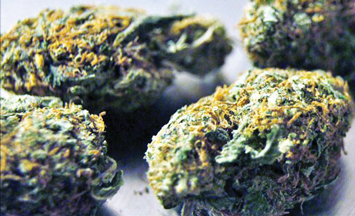The Pot Plot And The Chemical Assault On Black Masculinity
By Dr. Wesley Muhammad | Last updated: Feb 7, 2017 - 9:37:27 PMWhat's your opinion on this article?

|
The Black man loves his weed. Just ask some of the major hip hop artists. Few potheads, however, are aware of the fact that marijuana was covertly weaponized against Black people.

|
Much of the marijuana that hit the streets in the 1970s and 1980s was flown into the country from Latin America by CIA assets. It thus came through CIA hands before it fell into potheads’ hands.
But there is more to the “pot plot.” In 1975 the U.S. State Department paid Mexico to spray a dangerous weed killer called paraquat on Mexican marijuana fields. Much of American weed comes from Mexico via California. Paraquat, produced by the chemical giant Syngenta based in Basel, Switzerland, cannot only cause severe lung damage when inhaled and death when ingested; a growing body of research has also linked it to the onset of Parkinson’s disease. The Reagan administration began spraying the poison domestically on pot fields in national parks, and as recently as 2003 street marijuana tested positive for paraquat contamination.

|
What does this have to do with Black people? Paraquat is a toxic chemical with a strong melanin affinity, meaning it binds on melanin. Melanin is a naturally occurring pigment that colors hair, skin, and eyes. There is also melanin in the brain. This neuromelanin is mainly produced in the part of the brain called the substantia nigra. Paraquat binds and accumulates on melanin and the toxicant is gradually released into the cytosol (a component of the cytoplasm of a cell), causing damage to the melanin-containing tissue. Paraquat is believed to damage melanated brain tissue of the substantia nigra, contributing to the onset of Parkinson’s. Black people are of course the most melanated people on the planet, and this toxic chemical remains in Black bodies throughout life causing many physical and mental disorders. Paraquat’s strong melanin affinity therefore makes paraquat contaminated weed effectively an ethnic weapon, causing particular damage to Black (melanated) people.
Syngenta, the Swiss company that makes paraquat, also makes another wicked weed killer: Atrazine. In wildlife Atrazine causes the reduction of androgen (the male hormone) and elevation of estrogen (the female hormone) and thus demasculinizes males of various species, including humans. Dr. Tyrone Hayes, integrative biologist from the University of California, Berkeley, has demonstrated that in lower species atrazine completely reverses sex, physically feminizing male African clawed frogs, for example. Atrazine is not only used on America’s largest crop, corn, but it is also the most detected pesticide contaminant of ground, surface, and drinking water therefore exposing humans to the chemical’s feminizing effects. And there is a concentration of contaminated water around urban areas where the threatening “inner city Black male” dwells. An investigation done between 1999 and 2009 by Dr. Larry Barber of the U.S. Geological Survey revealed that another feminizing compound, alkylphenols, contaminates the water supply around large cities such as Chicago, Detroit, Indianapolis, and Akron, Ohio.
Black men thus seem to be chemically targeted through our water and through our weed.
Why target Black men? Psychiatrist Dr. Peter Breggin, an industry whistle-blower described as “the conscience of psychiatry,” explained:
“In the wake of the black urban uprisings of the late 1960s, America became preoccupied with the threatening figure of the young black male as well as the overall danger of rebellion and social chaos. Led by [the National Institute of Mental Health] and the Justice Department, the federal government began to develop an overall program for biomedical control of violence. … It … was inspired by fear of violence in the inner-city and aimed at control of young black males.”
This fear of the inner-city Black male that gripped America following the urban rebellions—Watts in 1965, Detroit in 1967, and then 100 cities after Dr. King’s assassination in 1968—inspired a governmental mandate to control young Black males, and the method of control would be biomedical: using drugs to control the young Black males’ biology. The chemicals that contaminate the weed that Black men smoke and the chemicals that contaminate the water that urban Black males use do the job.
Sources for this article include Colin A. Ross, M.D., The CIA Doctors: Human Rights Violations by American Psychiatrists (Manitou Communications, 2006); John Marks, The Search for the “Manchurian Candidate”: The CIA and Mind Control (New York and London: W.W. Norton & Company, 1991). Martin A. Lee and Bruce Shlain, Acid Dreams: The Complete Social History of LSD: The CIA, the Sixties, and Beyond (New York: Grove Weidenfeld, 1992). Alexander Cockburn and Jeffrey St. Clair, Whiteout: The CIA, Drugs and the Press (London and New York: Verson, 1999); “CIA and Big Bankers Key Drug Trade Players,” Spotlight August 8, 1988; Peter Hornbluh, “The paper trail to the top: Crack and the Contras,” The Baltimore Sun, November 17, 1996; “Plane in Fatal Crash Linked to Drug Running,” Associated Press July 28, 1988.
“Panic over Paraquat,” Time Magazine May 1, 1978; John Trux and Lee Torrey, “Poison Pot Probe,” New Scientist April 27, 1978. Danny Hakim, “This Pesticide Is Prohibited in Britain. Why Is It Still Being Exported,” The New York Times December 20, 2016; Andrew C. Revkin, “Paraquat: A Potent Weed Killer is Killing People,” Science Digest 91 (1983). Poisoning Pot – and People,” The New York Times August 19, 1983; Dale Russakoff, “Use of Paraquat to Kill Marijuana Stirs Protests,” The Washington Post August 25, 1983; “U.S. to Resume Using Paraquat on Marijuana,” The New York Times July 14, 1988. “Govt. Tests for Toxic Paraquat on U.S. Marijuana Supply According to ProCon.org FOIA Request,” ProCon.org January 15, 2009; Michael Isikoff, “DEA Finds Herbicides in Marijuana Samples,” The Washington Post July 26, 1989. B. Larsson, A. Oskarsson and H. Tjälve, “Binding of Paraquat and Diquat on Melanin,” Exp. Eye Res. 25 (1977). Oskar Karlsson and Nils Gunnar Lindquist, “Melanin affinity and its possible role in neurodegeneration,” Journal of Neural Transmission July 3, 2013. Carol Barnes, Melanin: The Chemical Key to Black Greatness (Chicago: Lushena Books, Inc., 1988). Tyrone B. Hayes, “There Is No Denying This: Defusing the Confusion about Atrazine,” BioScience 54 (2004); Tyrone B. Hayes et al, “Atrazine induces complete feminization and chemical castration in male African clawed frogs (Xenopus laevis),” PNAS 107 (2010); Tyrone B. Hayes et al, “Demasculinization and feminization of male gonads by atrazine: Consistent effects across vertebrate classes,” Journal of Steroid Biochemistry and Molecular Biology 127 (2011). Brian Bienkowski, “Hormone-Mimicking Chemicals Found throughout Great Lakes,” Scientific American March 23, 2015. Peter R. Breggin and Ginger Ross Breggen, “a biomedical program for urban violence control in the U.S.: the dangers of psychiatric social control,” Change: An International Journal of Psychology and Psychotherapy 11 (March 1993).
Dr. Wesley Muhammad’s book, Understanding the Assault on the Black Man, Black Manhood, and Black Masculinity (Atlanta, 2017) can be ordered at www.drwesleymuhammad.info.
INSIDE STORIES AND REVIEWS
-
-
About Harriett ... and the Negro Hollywood Road Show
By Rabiah Muhammad, Guest Columnist » Full Story -
Skepticism greets Jay-Z, NFL talk of inspiring change
By Bryan 18X Crawford and Richard B. Muhammad The Final Call Newspaper @TheFinalCall » Full Story -
The painful problem of Black girls and suicide
By Charlene Muhammad -National Correspondent- » Full Story -
Exploitation of Innocence - Report: Perceptions, policies hurting Black girls
By Charlene Muhammad -National Correspondent- » Full Story -
Big Ballin: Big ideas fuel a father’s Big Baller Brand and brash business sense
By Bryan Crawford -Contributing Writer- » Full Story






 Click Here Stay Connected!
Click Here Stay Connected!








